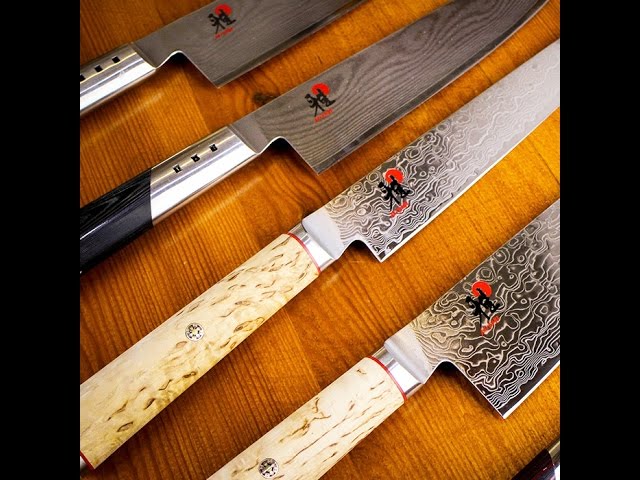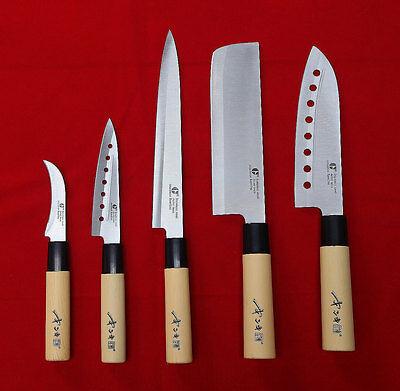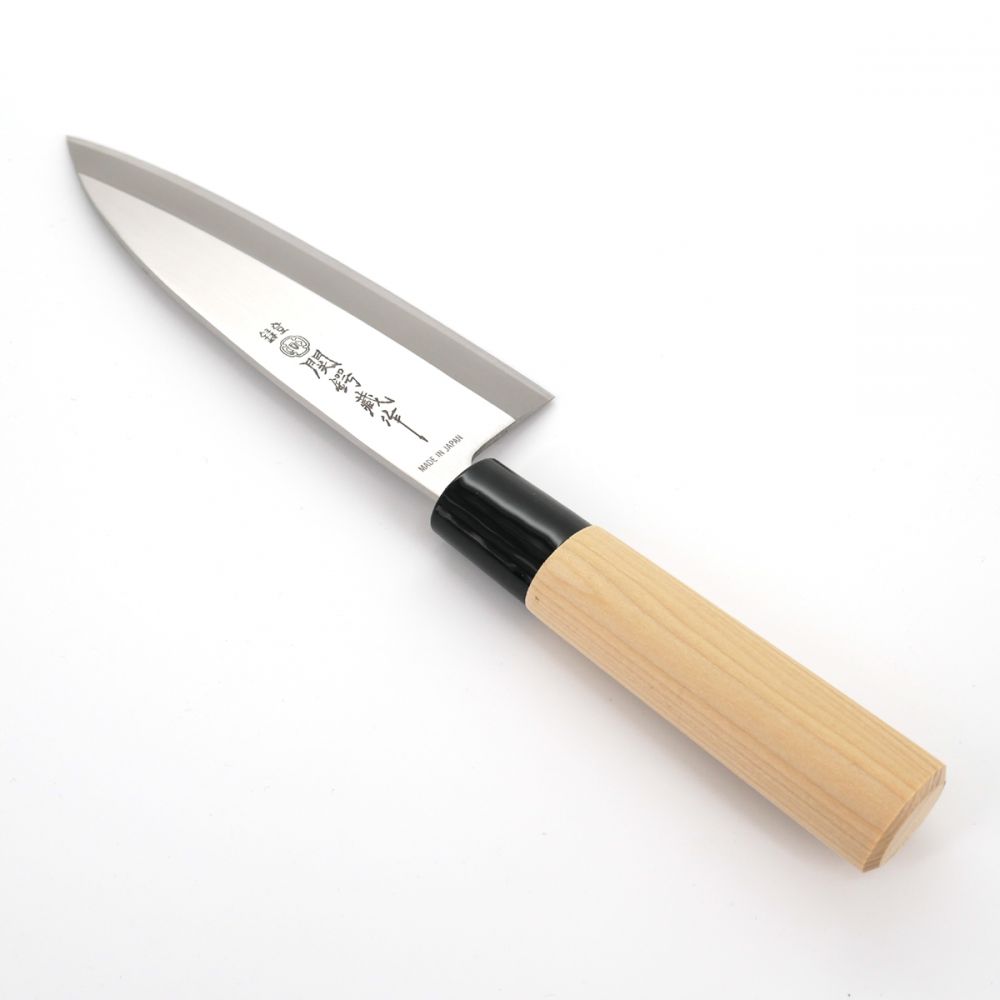Best Japanese kitchen knives
What Is The Best Japanese Knife?
The best Japanese knife is the knife that works best for you. When shopping for knives, Lau first asks his customers what they’ll be using their knives for. Professional chefs and home cooks usually have different needs: Professional chefs prefer to use their knives upwards of 40 hours of week, whereas home chefs typically use them for only twenty minutes a day to prep dinner. With that in mind, he recommends heavy-duty blades that have improved edge retention to experienced cooks, including the Korin Special Orange Handle knives. Lau adds that “ yanagis ” are popular amongst Japanese sushi chefs.
They’re standard Japanese slicers that have a single edge blade. Unlike Western style Japanese knives that have a double edge, single edge knives can achieve a super sharp cutting edge, ideal for the most clean cuts. For home cooks, Lau suggests a kitchen knife that’s easy to sharpen because “a knife you can’t sharpen is just a useless piece of metal,” he says. Inox Honyaki knives from the Suisin brand are a great choice. Aside from ease of sharpening, Lau suggests holding the knife to see what looks good for you. The shape of the handle and heft of the knife are considerations to remember.
The Ultimate Guide To Buying The Best Japanese Knives
Japanese kitchen knives have become a favorite of both amateur and professional chefs worldwide. Their super sharp, small, and lightweight blades make cooking food simpler and more enjoyable. But, what is the best Japanese kitchen knife? Of course, this is a very stupid question to ask. There is not ONE best knife out there, particularly when referring to Japanese knives. The best knife for you depends on a HUUUGE range of factors: your skill level, style of knife you prefer (i.e. traditional vs. Western), knife type required (i.e. what are you cutting?), your budget, and many other personal preferences.
There are a multitude of different types of Japanese knives to choose from, and the choices can be extremely overwhelming, particularly for amateur chefs (like myself) (like myself). Regardless of your current skill level though, you will find that a great knife will make cooking more fun, and help you become a better chef! In this buying guide, my goal is to highlight the important factors you want to remember before buying your own Japanese kitchen knives. I will then offer some recommendations of knives you may consider buying. Please note that this guide is intended for beginner, or at-home chefs. Hopefully, some experienced chefs will also find some of this knowledge useful when selecting a Japanese kitchen knife!
Price / Steel Type

Japanese knives can come in a wide range of prices…from about $50 to over $1000! Based on your ability level, you want to invest accordingly. More costly knives are usually made of super high carbon steel (i.e. blue steel or white steel) and are likely honyaki forged. High carbon steel knives are sharper, so they can keep their sharp edge longer, but are also susceptible to chipping if used improperly or not maintained properly. Proper maintenance and frequent sharpening are required for higher end knives. For this reason, these costly high-carbon steel knives are recommended only for professionals.
Cheaper, entry level Japanese knives would probably use some form of stainless steel alloy which is more durable, easier to maintain and resistant to rust. The downside is that cheaper knives will not maintain their sharpness as well as higher end knives if used at the same pace. Many at-home chefs should not think about this as they will not be using their knife almost as much as professionals. If you are just learning to cook, it is not important to buy a super expensive knife. You still want to have a quality knife, but there is no need to go overboard.
Think of it like buying a car. If you are still learning to drive, then there is no point in buying a Ferrari! A good, serviceable, cheap Japanese knife would probably cost about $100. Sword Style Japanese knives come in either double bevel (Western style) or single bevel blades (traditional Japanese style) . Single bevel knives are usually intended for skilled cooks, as they are can make very precise cuts, or have very unique use cases (e.g. sushi knives / yanagi). The feel of using a single-bevel knife is much different, and takes a lot of practice to get used to. If you are not a specialist, I would suggest a Western style blade to start as it is easier to use.
Japanese Kitchen Knife Recommendations
Below is an overview chart of several gyuto and santoku knife guidelines. This is not an exhaustive list by any way, but should help you get started. I would maybe add more different knife styles in the future. Again, this list is based on entry-level, budget friendly knives. Read on for a more detailed explanation of each knife.
Product Name Customer Rating
Best Gyuto / Japanese Chef Knives Tojiro DP Gyutou Yoshihiro VG10 Gyuto Chef’s Knife Shun Classic Chef’s Knife Best Santoku Tojiro DP Santoku MAC Superior Santoku Knife 6.5″ Yoshihiro VG-1 Gold Stainless Steel Santoku Exquisite! These knives are unlike any other kitchen knives I have ever used. They are light, thin, perfectly balanced, razor-sharp and the exquisite 45-layer mirrored finish and Japanese characters on the blade encourages you to cook, cook, cook! While they could easily be an objet d’art, they will be proudly displayed in our kitchen and used every day! Brand Name: Sakai Takayuki AUS10 45 Layer Mirrored Damascus Japanese Gyuto 210mm, Santoku 170mm& Petty 135mm Collection ★★★★★ January 30th, 2021
The Best Japanese Chef Knives Your Kitchen Needs In 2021

Your kitchen can be fitted with a large variety of tools and supplies, from slow cookers to knives. But if you’re thinking of investing in a new range of equipment, a knife is an asset. However, if you want to keep your kitchen looking sharp this 2021, you’ll face the dilemma of choose between a German or a Japanese knife. But let’s get one thing straight: Japanese knives are the cream of the crop in the cutlery world.
Their edge against other knives? Japanese knives are praised for their thin, sharp blade ensure that you can swiftly slice vegetables or even carve meats like a samurai without worrying if your blade will lose its sharpness at any time. Don’t worry, to help you out, we compiled the best knife sharpeners for any kind of blade t Ready to search for the best chef knife or a special blade for your cutlery needs? Look no further than our list of the best Japanese knives you can check out right now
What You Need To Consider Before Buying A Japanese Knife
Make sure you have a basic understanding of the best steel for knives , as well as how to handle a knife or before buying the first Japanese knife. Because some cutlery are forged from carbon steel, you’ll need to maintain them to prevent staining and rusting. Be cautious when washing Japanese knives as they are more delicate than their German (or Western) counterparts.
While Japanese-crafted cutlery needs less maintenance, it does not mean you can let it rot in your kitchen. Our advice? Read the care instructions after purchasing your Japanese blade to ensure it stays sharp and solid. Surely, no one wants to spend hundreds of dollars on a kitchen gadget just to have it rendered unusable after a few months.
Did You Know About The Difference Between Single/Double Bevel?
The angle of the bevel and the single/double bevel of knives provide a big difference to the cutting edge of a knife. A bevel is the tip of the knife that has been ground to give you the sharp cutting edge. If the knife has an edge that has been ground on just one side, with the other being smooth, it means that you have a single bevel knife. If you have a knife that has edges on both ends, then it is a double bevel knife. Most of the knives that you come across are likely to have a bevel on both sides, however, Japanese knives usually come with a single bevel.
Did You Know Why Japanese Cooks Use Single Bevel Knives?
 The choice of single bevel knives by Japanese chefs is largely due to the fact that single bevels permit the chefs to perform vey fine cuts on vegetables. Japanese cuisine is popular the use of ingredients that are cut very fine. Single bevel knives have the capability to cut very fine slices, since the cutting edge conducts the slicing operation while the straight side assists in getting deeper into the vegetable.
The choice of single bevel knives by Japanese chefs is largely due to the fact that single bevels permit the chefs to perform vey fine cuts on vegetables. Japanese cuisine is popular the use of ingredients that are cut very fine. Single bevel knives have the capability to cut very fine slices, since the cutting edge conducts the slicing operation while the straight side assists in getting deeper into the vegetable.
This is done in a manner that is even and consistent, which might not be possible with a double bevel knife that will spread open the vegetables on both sides with the cutting edges. Did you know there are four different qualities to differentiate a Japanese knife? There are four different characteristics that differentiate the best Japanese knives from other knives. These are – the handle design, the blade edge, the form of steel, and the construction of the knife. The handle as described above is built differently to give a robust and reliable grip to the knife.
The blade edge is single bevel to give the cook greater control in slicing very fine cuts. The type of steel that is used is stainless steel unlike certain other types of knives that are carbon steel. The design is laminated, unlike monosteel construction. These are the four distinct distinguishing characteristics of a Japanese knife.
Did You Know The Average (Ideal) Length Of Japanese Knives ?
The length of Japanese sous knives varies anywhere from 6.5 and 10 inches. However, the optimal length will be 8 inches, as this will permit you to cut with largely sized vegetables without having to switch from end to end. A knife that is very small will have to be used in a repetitive motion from one end to the other end, whereas a long blade can be used to slice cleanly in one single motion. However, a very long knife would be ungainly and difficult to use and store.
There select one according to the availability of room in your kitchen and also the specifications. Did you know that Japan cooking knife handles are burned in for the perfect fit? The specialty of the Japanese knives is not only in the blades, but also in the handles. A Japanese blade usually has its handle burnt in and friction fitted. This helps to provide the ideal fit and also stops the handle from splitting.
Japanese knives are renowned for high performance and this is actually an all round affair. Imagine making a nice knife, with the handle damaged? You still would not be in a position to do anything useful with such a knife. This is why best Japanese kitchen knives are made with a sturdy and durable handle, either from a composite material or from superior quality wood.
Sous Samurai: 10 Best Japanese Chef Knives
Although there are several pieces of gear that have the ability to be well-built regardless of where they are from, there are also unique regions recognized for those styles. Japan, for instance, is known for making superb denim . But there is also something else for which the Asian island and its native craftsmen are known: knives.
More precisely, some of the finest kitchen cutlery in the world comes from that tiny island nation on the eastern side of the Pacific ocean. And that’s a pretty big deal, given that a knife is probably the most valuable tool any cook can have in their arsenal. It is with this in mind that we put together the following list of the 10 best chef knives crafted by Japanese craftsman, in Japan, and/or from Japanese materials. If you count yourself a foodie, these kitchen gadgets are not to be missed.






